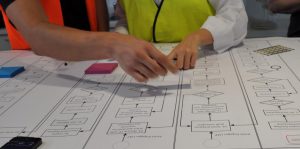ADVANCED MANUFACTURING | TRANSFORMING WORKPLACE COMPETENCY
The full benefit of integrating advanced Industry 4.0 technologies into manufacturing processes requires
the right human skills and a motivated workforce. While the new manufacturing paradigm is projected to
create a whole new range of possibilities, it depends upon a workforce transformation that is one of the
main challenges of Industry 4.0.
Increasing automation will force a shift in the employee skill-set. Initially some low-skill jobs will be
lost, particularly those with repetitive tasks, others however, will be reconfigured. In the long-term,
employment is projected to rise; and people with skills overlapping the domains of engineering, IT and
software development will benefit most. Leaders need to consider the changing nature of work, and
organisations need to provide environments that expand the skill-set and capabilities of existing employees
through continuous, on-the-job education and training. An ongoing investment in upskilling the workforce
will help address challenges and fears about job losses through automation.
Key Recommendations
- Identify a Project Champion Develop an employee-led transformation culture and support those with the energy and enthusiasm to drive projects forward
- Collaborate with Your Workforce Identify opportunities and reconfigure processes in partnership with your employees
- Develop and Support a Culture of Life-long Learning Provide workplace education, training, and opportunities to experiment
- Acknowledge and Document Failures Create the space to fail and learn
There’s no winning and losing, only winning and learning

Activity map advanced manufacturing opportunities over existing workflows
A foundation for successful adoption and application of advanced technology can be achieved through early
engagement with employees. Collaborative activities can investigate current organisational workflows to
identify opportunities for the use of advanced manufacturing equipment. For example, points in the workflow
that are resource intensive, time consuming, hazardous, or difficult to achieve with existing methods. They
could also be processes where advanced manufacturing equipment would expand the capabilities of the
organisation. These approaches allow organisations to identify what technology should be adopted and how. It
is important to consider if there is enough work [for the technology] in the process and what resources
would be required for implementation to be successful. Having employees as key participants in this
transformation is critical as their expert, and often tacit knowledge informs what advanced manufacturing
technologies would be appropriate and useful uptake into their processes.
By adopting a collaborative approach, organisations provide their employees with opportunities to learn more
about the capabilities of advanced manufacturing technologies and how they can allow for transformative
approaches within their workflow. This kind of engagement and communication increases valuable
cross-department awareness and opens up the opportunity for employee-led transformation – a key driver of
successful industrial transformation.
As the transformation continues, this internal value should be supported and built upon with long-term
strategies that include ongoing training and education. To accommodate different generations, skill-levels
and learning styles, a variety of training approaches should be considered – formal versus informal, onsite
versus offsite, for example. Collaborative activities such as the workflow mapping discussed above, are
approachable methods that can be organised in-house or supported through partnerships with research
institutions or government vocational education training. If opportunity allows, it is recommended that
organisations consider both practice and applied use; ‘time on the tool’, for exploration and
experimentation with the technology, understanding its limitations and learning from failures, will increase
employee self-efficacy; actually applying the technology to projects will demonstrate confidence in the
workforce.
The Future of Manufacturing
With support from the Innovative Manufacturing Cooperative Research Centre (IMCRC), Design Robotics is collaborating to present a range of new
fabrication and vision systems solutions. The goal is simple – to design for human intelligence and optimize
the relationship between people and machines.
Pushing the limits of industrial robotics is a move to empower people. Navigating the increasing complexity
of manufacturing inevitably supports human experience and enhances skills acquisition. At its heart, this
approach celebrates the best of what robots and machines can achieve – problem-solving, and the best of what
humans can do – social intelligence and contextual understanding.
Resources
- Australian Government Department of Education and Training
- World Economic Forum – Leading_through_the_Fourth_Industrial_Revolution.pdf
- The Centre for Future Work – (Report) Advanced Skills for Advanced Manufacturing
- G20 Blueprint on Innovative Growth
- G20 New Industrial Revolution Action Plan
- Deloitte – Manufacturing Jobs in the Digital Era
- Mckinsey – What is the Future of Work
- OECD – Future of Work
- Institute for the Future (IFTF) – Work Skills
Collaborative Tools
{#collaborative-activities-tools}